Solidigm D7-P5810 800GB Linux Performance
Our first test was to see sequential transfer rates and 4K random IOPS performance for the Solidigm D7-P5810. Please excuse the smaller-than-normal comparison set. In the next section, you will see why we have a reduced set. The main reason is that we swapped to a multi-architectural test lab. We actually tested these in over two dozen different processor architectures spanning PCIe Gen4 and Gen5. Still, we wanted to take a look at the performance of the drives.
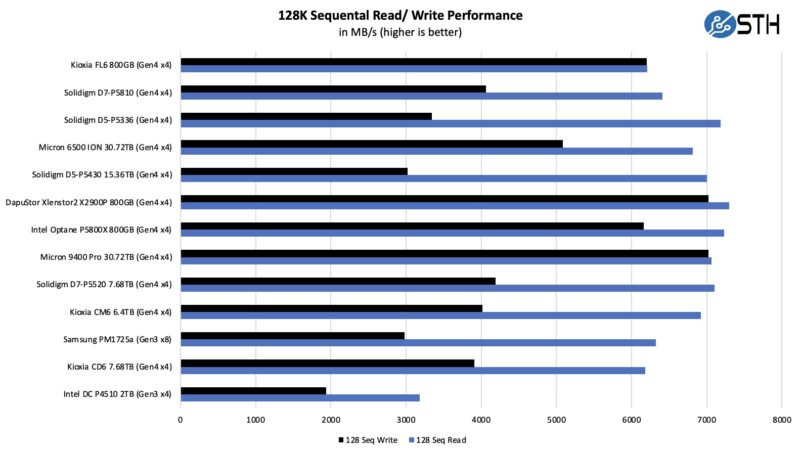
Here is the 4K random read-and-write performance:
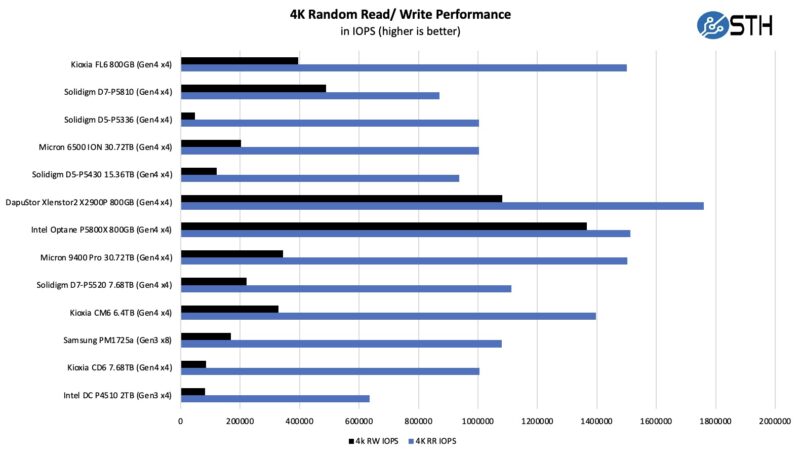
Here we can see something really interesting. Drives like the Intel Optane P5800X dominate the space, and the DapuStor Xlenstor2 X2900P gives it a solid run as an alternative. Other write endurance optimized drives like the Kioxia FL6 are more like an alternative to the D7-P5810 trading wins here.
Solidigm D7-P5810 800GB Application Performance Comparison
For our application testing performance, we are still using AMD EPYC. We have all of these working on x86 but we do not have all working on Arm and POWER9 yet so this is still an x86 workload.
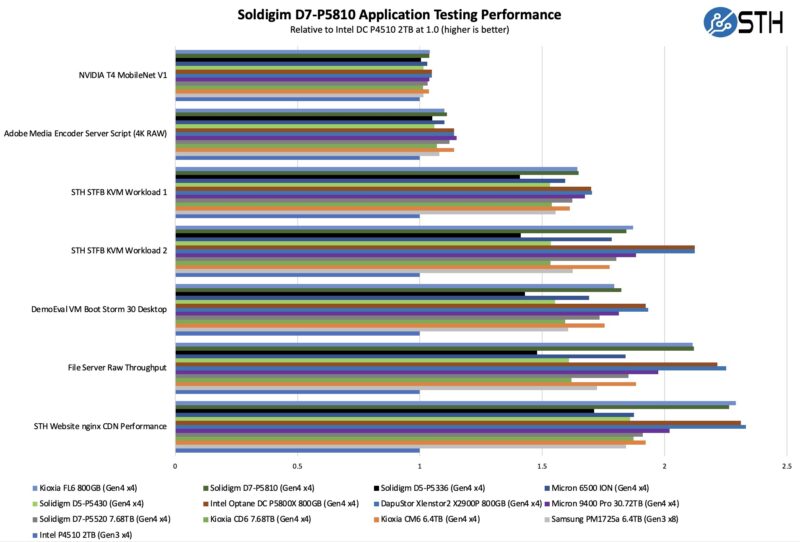
As you can see, there are a lot of variabilities here in terms of how much impact the Solidigm has on application performance. Let us go through and discuss the performance drivers.
On the NVIDIA T4 MobileNet V1 script, we see very little performance impact on the AI workload, but we see some. The key here is that the performance of the NVIDIA T4 mostly limits us, and storage is not the bottleneck. We have a NVIDIA L4 that we are going to use with an updated model in the future. Here, we can see a small benefit to the newer drives in terms of performance, but it is not huge. That is part of the overall story. Most reviews of storage products are focused mostly on lines, and it may be exciting to see sequential throughput double in PCIe Gen3 to PCIe Gen4, but in many real workloads, the stress of a system is not solely in the storage.
Likewise, our Adobe Media Encoder script is timing copy to the drive, then the transcoding of the video file, followed by the transfer off of the drive. Here, we have a bigger impact because we have some larger sequential reads/ writes involved, the primary performance driver is the encoding speed. The key takeaway from these tests is that if you are mostly compute-limited but still need to go to storage for some parts of a workflow, the SSD can make a difference in the end-to-end workflow.
On the KVM virtualization testing, we see heavier reliance upon storage. The first KVM virtualization Workload 1 is more CPU limited than Workload 2 or the VM Boot Storm workload, so we see strong performance, albeit not as much as the other two. These are KVM virtualization-based workloads where our client is testing how many VMs it can have online at a given time while completing work under the target SLA. Each VM is a self-contained worker. We know, based on our performance profiling, that Workload 2, due to the databases being used, actually scales better with fast storage whereas Workload 1 scales better with CPUs. Overall, these are perhaps a tier below the more exotic drives like the (now discontinued) Optane solutions, but also a tier above general purpose SSDs.
Moving to the file server and nginx CDN, we see very solid QoS numbers from the Solidigm. On the filer server, it was a bit behind the higher-cost drives but with good overall performance. On the nginx CDN test, we are using an old snapshot and access patterns from the STH website, with caching disabled, to show what the performance looks like in that case. Here is a quick look at the distribution:
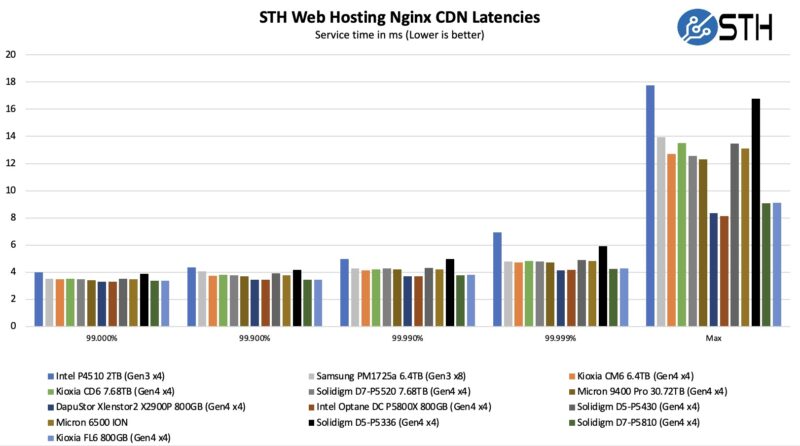
Here is where we can really see the big delta between a SCM-class device and a capacity-focused SSD. The gap is not overly present at the 99% but by the time we hit five-9’s the gap is huge. There is always some application-related latency, but overall, this is great performance. There seems to be a tier with the Kioxia FL6 and the Solidigm D7-P5810 that sits between the ultra-fast SCM-class drives, and then the more standard SSDs.
Now, for the big project: we tested these drives using every PCIe Gen4 architecture and all the new PCIe Gen5 architectures we could find, and not just x86, nor even just servers that are available in the US.



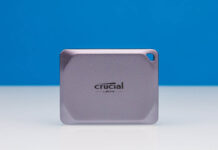
Intel SSDs were my goto during the long 6-Gbit SATA era (while supporting 5K Linux servers).
Dumb question:
Would the QLC 60TB running in SLC mode (15TB) perform as well as this? Or would the excess capacity slow it down?
You mentioning it and the SLC mode stuff made me realize we have the capability for 15TB SLC SSDs and nobody is really putting anything into that.
Give us back optane!
FInally, SLC.
This is actually not true SLC, it has QLC dies ran in pure pseudo SLC
Even more hilariously, the QLC drives are 5LC running in QLC
Optane is too good of a tech to allow it to die. Fixes 100% of the problems with NAND.
SLC gets you part of the way there but with the same limitations with all NAND.
I just finished our new SAN – all 2S SPR, 2TB, 2x Bluefield 3 (400GbE), 2x ConnectX7 (400GbE) – 24 x NVMe in a 2U Supermicro chassis.
Tier 0 is 4 servers and 280TB of Optane storage (4x70TB) ZFS with single parity.
Tier 1 is 12 servers and 4PB of Intel Enterprise NAND and dual parity ZFS.
Tier 2 is 45 drive top loaders (3) from Supermicro with 14TB Exos dual 12Gb/s SAS. These are limited to ConnectX6 and 2x100GbE / 200GbE.
Tier 3 is soon to be decommissioned Supermicro 90 drive top loaders.
I Picked up the Optane and NAND drives for less than half cost after the Solidigm branded drives started appearing. Still have over 2PB of NAND and 300TB of Optane in reserve.
Intel NAND was always superior to other NAND and Optane has no peer.